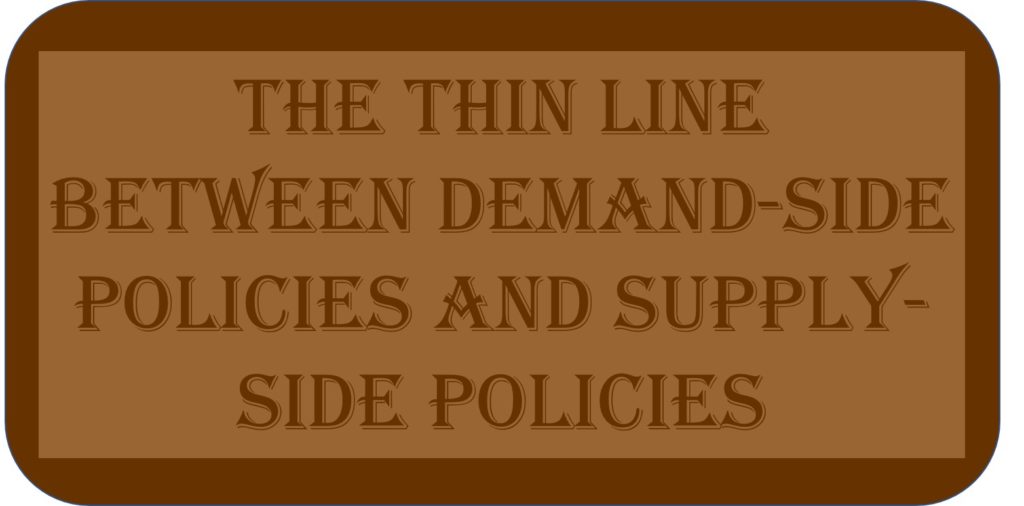The Thin Line Between Demand-side Policies and Supply-side Policies
The government has four macroeconomic policy objectives of low unemployment, low inflation, high economic growth and a balance of payments equilibrium. However, there is no guarantee that the four macroeconomic policy objectives will be achieved. In other words, the economy may experience the four macroeconomic problems of high unemployment, high inflation, low economic growth and a persistent balance of payments disequilibrium. In these circumstances, the government may implement policies to solve or reduce the problems. The two commonly used types of macroeconomic policies are demand-side policies and supply-side policies. However, the thin line between the two types of macroeconomic policies has led to confusion and conflicts. In order to have a fuller understanding of the four macroeconomic policy objectives of the government, one can get economics tuition. This is particularly easy in Singapore due to the large number of economics tuition centres. For example, there are at least four educational centres in Bishan which provides economics tuition and they include Economics Cafe, Learners’ Lodge, Economics Focus and Adam Smith. In particular, Economics Cafe was founded by Mr. Edmund Quek who is a reputable and renowned economics tutor in Singapore.
The Supply-side Effect Of Demand-side Policies
Demand-side policies, which include fiscal policy and monetary policy, are policies that are used to influence aggregate demand. In times of high inflationary pressures, the central bank can use contractionary monetary policy to reduce inflation. In order to decrease the supply of money, the central bank can sell government securities which is commonly called an open market sale. When the supply of money falls, the amount of reserves in the banking system will fall. When this happens, banks will find it harder to borrow reserves and this will lead to a rise in the interest rates charged on loans made between banks which are commonly called interbank rates. A rise in interbank rates will lead to a rise in the level of interest rates in the economy. When this happens, the growth of consumption expenditure and investment expenditure will fall which will reduce the growth of aggregate demand resulting in lower inflation. If the above explanation sounds too complex to you, you may approach a good economics tutor at a reputable economics tuition centre in Singapore. As mentioned earlier, there are at least four good economics tuition centres in Bishan. A rise in interest rates, however, will not only reduce the growth of aggregate demand, it will also reduce the growth of aggregate supply. When the growth of investment expenditure falls due to a rise in interest rates, there will be a negative effect on the growth of the production capacity in the economy which will negatively affect the growth of aggregate supply. When this happens, inflation will be higher. Therefore, although demand-side policies can be used to reduce inflation in the short run, the supply-side effect will lead to higher inflation in the long run.
The Demand-side Effect Of Supply-side Policies
Supply-side policies, which include education and training and research and development, are policies that are used to increase aggregate supply through increasing the production capacity in the economy. Supply-side policies can be used by the government to reduce inflation. As the efficiency of capital or the skills and knowledge of labour in the economy increases, the production capacity in the economy will increase. When this happens, inflation will be lower. However, the use of supply-side policies to reduce inflation may lead to an increase in aggregate demand. For example, the government may set up more educational institutes in order to increase the skills and knowledge of labour in the economy. Although the increase in the skills and knowledge of labour in the economy will lead to an increase in aggregate supply in the long run resulting in lower inflation, the increase in government expenditure on education and training will lead to an increase in aggregate demand in the short run resulting in higher inflation. Therefore, although supply-side policies can be used to reduce inflation in the long run, the demand-side effect will lead to higher inflation in the short run.
Economics Cafe is a leading educational centre in Singapore which specializes in economics tuition. The economics tutor conducts courses which cater for individuals who are interested in learning economics for examination and for leisure.
Benjamin Tay
Economics Tuition Singapore @ Economics Cafe
Principal Economics Tutor: Mr. Edmund Quek


